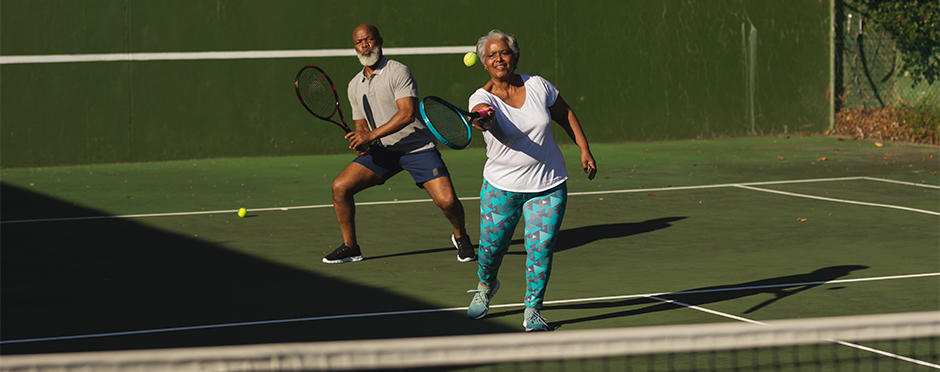
Common Injuries in the Aging Athlete
Leave a CommentMore and more health care providers are seeing an increase in “Boomeritis,” a term coined by Nicholas DiNubile in 1999, referring to the musculoskeletal injuries that the aging athlete in the baby boomer generation, 1946-1964, are experiencing. This group of athletes is the first generation to grow up exercising and continue exercising well into their 70s. The musculoskeletal injuries in Boomeritis include tendon, muscle, and ligament tears and stress fractures. While these injuries can happen at any age, physiologic changes with age make this generation more susceptible to developing these problems.
Unfortunately, no matter what we do to prevent it, athletic performance declines with age. Modest decreases occur at age 50-60 years; after that is a more progressive, steeper decline1. The aging process has been linked to decreased muscle mass and muscle function referred to as sacropenia1. There is an average loss of 15% of muscle mass between the ages of 30 and 60 and a loss of 30% after age 601. These changes are associated with decreased stamina, increased insulin resistance, and generalized loss of force and power1. Aging also affects our tendons, basically increasing their stiffness, causing tendinopathy – a painful condition occurring in and around tendons in response to overuse.
Along with tendon and muscle changes, considerable bone loss can occur with aging in men and women; however, menopause and a decrease in circulating estrogens in women are more severely affected than men1. The aging process can alter the pathophysiology of bone, causing osteoporosis if untreated.
These physiologic changes in bone, muscle, and tendon result in a general decrease in these musculoskeletal components’ ability to withstand high-impact physical activities.
Common musculoskeletal injuries in the aging athlete:
- Muscle strains – most muscle injuries to the lower leg involve the calf muscles.
- Medial tibial stress syndrome or “shin splints” – exercise-related pain and pain to palpation at the tibia.
- Stress Fractures – most common in the lower extremity, tibia, and foot.
- Achilles Tendon tears – subjected to the highest loads in the body during running and jumping, taking loads up to 10 times our body weight, and most often injured in basketball, volleyball, racket sports, and running.
- Plantar Fasciitis – the plantar fascia is one of the most important structures of the foot and is vital for stabilizing the arch of the foot and is a common source of pain.
- Osteoarthritis – Can occur in any joint, most commonly in the knee, shoulder, and hip.
- Adhesive Capsulitis – progressive loss of shoulder motion and pain elicited with movement.
- Rotator cuff abnormalities or tears – pain and shoulder stiffness usually occur in the absence of any specific injury.
- Abnormalities of the long head of the biceps tendon – instability and pain at the shoulder; often occur with rotator cuff tears.
- Medial Epicondylitis or “golfer’s elbow” – medial elbow pain caused by repetitive stress and flexion of the elbow, prevalence is highest among golfers older than 50 years of age.
- Lateral Epicondylitis or “tennis elbow” – lateral elbow pain, onset usually occurs after the fourth decade of life and in athletes who participate in racket support with a repeated rotatory movement of their forearm.
- Tendinosis of the biceps tendon or tear – affects the aging bodybuilder or weightlifter, usually hears or senses a “pop” while performing a resisted exercise, such as a bicep curl or deadlift, and can have a visible deformity known as a “popeye deformity.”
- Injury to the Triangular Fibrocartilage Complex (TFCC) – medial wrist pain and an audible or palpable click, associated with swelling and loss of grip strength. Associated with golf, kickboxing, and basketball. 40% of aging athletes in the fifth decade of life and more than 50% older than 60 years report an injury to their TFCC2
- Impaction syndromes of the wrist – common in weightlifting, racket sports, and pushups. It is a degenerative condition characterized by medial wrist pain, swelling, and decreased range of motion.
There is good news, though; it has been shown that lifelong physical activity can slow the overall loss of bone and muscle mass that occurs with aging1. This being said, we want to support and encourage physical activity among aging individuals despite the increased risk of musculoskeletal injuries that can occur due to aging.
If you are experiencing any musculoskeletal symptoms preventing you from staying physically active and doing what you love, seek help from a physical therapist. Start by scheduling a Free Assessment where one of our experts can assess your functional strength and mobility and recommend a customized treatment program to fit your needs.
The Athletico blog is an educational resource written by Athletico employees. Athletico bloggers are licensed professionals who abide by the code of ethics outlined by their respective professional associations. The content published in blog posts represents the opinion of the individual author based on their expertise and experience. The content provided in this blog is for informational purposes only, does not constitute medical advice and should not be relied on for making personal health decisions.
References:
1. Quatman C, Yu J. The Aging Athlete: Part 1, “Boomeritis” of the Lower Extremity. AJR. 2012; 199: 295-306.
2. Quatman C, Yu J. The Aging Athlete: Part 2, “Boomeritis” of the Upper Extremity. AJR. 2012; 199: 307-321.
